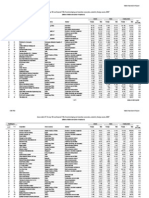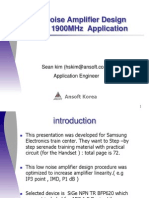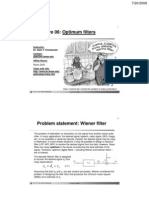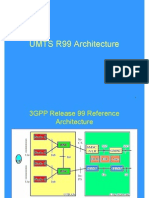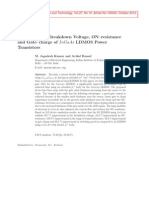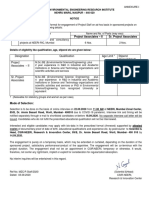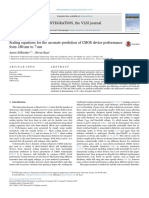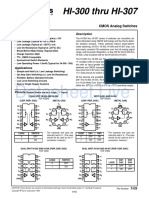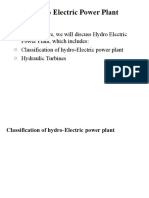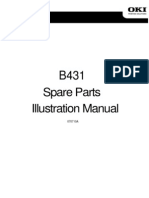Low-Noise Amplifier Design and Optimization: Master'S Thesis
Low-Noise Amplifier Design and Optimization: Master'S Thesis
Uploaded by
jitu123456789Copyright:
Available Formats
Low-Noise Amplifier Design and Optimization: Master'S Thesis
Low-Noise Amplifier Design and Optimization: Master'S Thesis
Uploaded by
jitu123456789Original Title
Copyright
Available Formats
Share this document
Did you find this document useful?
Is this content inappropriate?
Copyright:
Available Formats
Low-Noise Amplifier Design and Optimization: Master'S Thesis
Low-Noise Amplifier Design and Optimization: Master'S Thesis
Uploaded by
jitu123456789Copyright:
Available Formats
2008:230 CIV
MASTER' S THESI S
Low-Noise Amplifier Design
and Optimization
Marcus Edwall
Lule University of Technology
MSc Programmes in Engineering
Electrical Engineering
Department of Computer Science and Electrical Engineering
Division of EISLAB
2008:230 CIV - ISSN: 1402-1617 - ISRN: LTU-EX--08/230--SE
ABSTRACT
Low-Noise Ampliers are key components in the receiving end of nearly every communi-
cations system. The wanted input signal of these systems is usually very weak and the
primary purpose of the LNA is consequently to amplify the signal while at the same time
adding as little additional noise as possible. Its performance is measured in a number
of gures of merit among which gain and noise gure are most notable while dynamic
range, return loss and stability are examples of others.
In May 2005 a four year design study entitled EISCAT 3D was initialized. Its purpose
was to investigate the feasibility of a next-generation incoherent scatter radar system.
One of the responsibilities of EISLAB at Lulea University of Technology is to design a
receiver front-end, which include an LNA with extremely high performance requirements.
For that reason a MATLAB Particle Swarm Optimization implementation was developed
to iteratively nd a solution to optimal component values for a user denable LNA
topology.
In this masters thesis, the radio frequency concepts essential to traditional LNA design
as well as the design procedure itself are explained. A description to the optimizer is
then given, including a chapter on 2-port noise calculations.
With the objective to nd an LNA design with even higher performance than the
previously designed EISCAT 3D LNA, four topologies are evaluated using the optimizer
while consistently targeting the EISCAT 3D specications. These topologies include the
original reference design and one that employs the inductive source degeneration design
technique. The latter showed signicantly improved performance with an approximate 2
dB gain increase and 0.1 dB noise gure reduction while still maintaining the return loss
and stability requirements.
iii
PREFACE
This masters thesis was carried out at the Embedded Internet Systems Laboratory (EIS-
LAB), Department of Computer Science and Electrical Engineering, Lulea University of
Technology and was descendant to the EISCAT 3D design study.
Among the people that I would like to thank for their contribution to my masters thesis
are Dr. Jonny Johansson for his encouragement and insightful help, and my supervisor,
Ph.D. student Johan Borg for his invaluable expertise.
On a personal level, I wish to express gratitude to family and friends who have sup-
ported me throughout this journey.
Marcus Edwall
v
CONTENTS
Chapter 1: Introduction 1
Chapter 2: Radio Frequency Concepts 3
2.1 Reection . . . . . . . . . . . . . . . . . . . . . . . . . . . . . . . . . . . 3
2.2 Scattering Parameters . . . . . . . . . . . . . . . . . . . . . . . . . . . . 5
2.3 The Smith Chart . . . . . . . . . . . . . . . . . . . . . . . . . . . . . . . 6
2.4 The Quality Factor . . . . . . . . . . . . . . . . . . . . . . . . . . . . . . 7
2.5 Impedance Transformation . . . . . . . . . . . . . . . . . . . . . . . . . . 7
Chapter 3: Low-Noise Amplifier Design Strategy 9
3.1 Target Specications . . . . . . . . . . . . . . . . . . . . . . . . . . . . . 9
3.2 Active Device Selection . . . . . . . . . . . . . . . . . . . . . . . . . . . . 14
3.3 DC Bias Network Design . . . . . . . . . . . . . . . . . . . . . . . . . . . 15
3.4 Matching Network Design . . . . . . . . . . . . . . . . . . . . . . . . . . 15
3.5 Noise Optimization . . . . . . . . . . . . . . . . . . . . . . . . . . . . . . 17
3.6 Low-Noise Amplier Topologies . . . . . . . . . . . . . . . . . . . . . . . 17
3.7 Determining
S
and
L
. . . . . . . . . . . . . . . . . . . . . . . . . . . . 19
Chapter 4: 2-ports and Noise 23
4.1 Method of Linear 2-port Noise Analysis . . . . . . . . . . . . . . . . . . . 23
Chapter 5: The Optimizer 27
5.1 Description . . . . . . . . . . . . . . . . . . . . . . . . . . . . . . . . . . 27
5.2 Notable functions . . . . . . . . . . . . . . . . . . . . . . . . . . . . . . . 28
5.3 Usage . . . . . . . . . . . . . . . . . . . . . . . . . . . . . . . . . . . . . 28
Chapter 6: LNA Topology Evaluation 31
6.1 Circuit 1: Original . . . . . . . . . . . . . . . . . . . . . . . . . . . . . . 32
6.2 Circuit 2: Simplied . . . . . . . . . . . . . . . . . . . . . . . . . . . . . 32
6.3 Circuit 3: Without Feedback . . . . . . . . . . . . . . . . . . . . . . . . . 33
6.4 Circuit 4: Inductive Source Degeneration . . . . . . . . . . . . . . . . . . 34
Chapter 7: Conclusion 39
CHAPTER 1
Introduction
The European Incoherent Scatter Association (EISCAT) is an international research
organization that operates four incoherent scatter radars located in northern Scandinavia.
These are used to provide ionospheric radar observations for geophysical environmental
monitoring, modelling and forecasting as well as plasma physics research.
To meet increasing demands and maintain world leadership in this eld a four year
design study, EISCAT 3D [1], is underway since May 2005. This next-generation inco-
herent scatter radar system is based on large phased array VHF antennas. The potential
of the system will exceed all other similar facilities both existing and under construction.
Among the involved parties is Lulea University of Technology (LTU) whose main re-
sponsibility is the phased array receivers, including a low-noise amplier (LNA). Because
of the extreme performance requisites, no commercially available pre-built product ex-
hibit specications near those required. Particular emphasis has therefore been put on
design and optimization of these critical components.
The work presented in this masters thesis includes a description of conventional design
and optimization techniques for an LNA. In addition, a MATLAB particle swarm opti-
mization implementation, a tool developed within the EISCAT 3D framework, has been
used to evaluate variations of an LNA design and optimize its associated performance
parameters. A signicant portion of the work was founded in rstly the recognition of
underlying principles of LNA design and secondly understanding of the optimizer.
1
CHAPTER 2
Radio Frequency Concepts
For a fundamental understanding of the Low-Noise Amplier design procedure, it is nec-
essary to introduce a series of underlying concepts. Covered topics include reection,
scattering parameters, the Smith Chart, the quality factor, and impedance transforma-
tion. Further information on this topic can be found in [2] and [3] on which this and the
next chapter are based.
2.1 Reection
When a power wave travels through an impedance discontinuity, at that junction (Fig-
ure 2.1), a fraction of the wave will be reected. As a consequence, the counterpart (the
incident wave) will lose some of its magnitude. Naturally, this is an undesirable phe-
nomenon in any application where power conservation is critical. The extent of incident
power loss is related to the similarity of the impedances as seen in both directions from
the junction. So the objective, in order to maximize the power transfer, is to optimize
the impedance match. Further information on that subject follows in Chapter 3.
There are a number of performance parameters that show to what extent the impedances
are matched. Firstly, the Reection Coecient which by denition is the ratio of the
reected wave to the incident wave (Equation 2.1), but can also be expressed in terms of
impedances. It is a complex entity that describes not only the magnitude of the reection,
but also the phase shift.
L
=
Reflected wave
Incident wave
=
Z
L
Z
S
Z
L
+Z
S
(2.1)
Note that this is the load reection coecient with respect to the source impedance. It
is also commonly expressed with respect to the characteristic impedance (Z
0
). When the
load is short-circuited, maximum negative reection occurs and the reection coecient
assumes minus unity. In contrast, when the load is open-circuited, maximum positive
3
4 RF Concepts
Z
S
Z
L
L
Figure 2.1: Simple circuit showing the impedance discontinuity junction and measurement lo-
cation of
L
.
Figure 2.2: Incident wave (solid), reected wave (dashed) and standing wave (dotted).
reection occurs and the reection coecient assumes plus unity. In the ideal case, when
Z
L
is perfectly matched to Z
S
, there is no reection and the reection coecient is
consequently zero.
A closely related parameter is the Voltage Standing Wave Ratio (VSWR), which is
commonly talked about in transmission line applications. As the incident and reected
wave travel in opposite directions the addition of the two generates a standing wave, see
Figure 2.2. The VSWR is dened as the ratio of the maximum voltage to the adjacent
minimum voltage of that standing wave (Equation 2.2). Knowing the domain of the
reection coecient, it follows that when there is no reection as in a perfectly matched
system; VSWR assumes its minimum and ideal value of 1.0:1.
V SWR =
|V |
max
|V |
min
=
1 + |
L
|
1 |
L
|
(2.2)
The Return Loss (RL) is simply the magnitude of the reection coecient in decibels
2.2. Scattering Parameters 5
2-port
a
2
a
1
b
2
b
1
Figure 2.3: A 2-port with incident waves a
1
and a
2
, and reected waves b
1
and b
2
.
(Equation 2.3). At times it is specied whether the return loss is measured on the input-
or output side of the Device Under Test (DUT), with corresponding IRL and ORL
naming. It should be mentioned that the return loss is occasionally expressed without
the leading minus sign ending up with a negative RL. This is incorrect however as RL
should be positive.
RL = 20log|| (2.3)
2.2 Scattering Parameters
Scattering Parameters or S-parameters are complex numbers that exhibit how voltage
waves propagate in the radio-frequency (RF) environment. In matrix form they charac-
terize the complete RF behaviour of a network.
At this point it is necessary to introduce the concept of 2-ports. It is fundamental in RF
circuit analysis and simulation as it enables representation of networks by a single device.
As the properties of the individual components and those of the physical structure of the
circuit are eectively taken out of the equation, circuit analysis is greatly simplied. The
characteristics of the 2-port is represented by a set of four S-parameters: S
11
, S
12
, S
21
and S
22
, which correspond to input reection coecient, reverse gain coecient, forward
gain coecient and output reection coecient respectively. The concept of 2-ports is
further described in Chapter 4 where noise calculations of linear 2-ports are addressed.
There are alternative descriptive parameters for 2-ports, such as impedance param-
eters, admittance parameters, chain parameters and hybrid parameters. These are all
measured on the basis of short- and open circuit tests which are hard to carry out accu-
rately at high frequencies. S-parameters, on the other hand, are measured under matched
and mismatched conditions. This is why S-parameters are favoured in microwave appli-
cations. S-parameters are both frequency- and system impedance dependent so although
manufacturers typically supply S-parameter data with their devices it is not always ap-
6 RF Concepts
plicable. Under such circumstances, it becomes necessary to measure the parameters.
Referring to Figure 2.3, these measurements are carried out by measuring wave ratios
while systematically altering the termination to cancel either forward gain or reverse gain
according to the following equations:
S
11
=
b
1
a
1
a
2
=0
(2.4)
S
12
=
b
1
a
2
a
1
=0
(2.5)
S
21
=
b
2
a
1
a
2
=0
(2.6)
S
22
=
b
2
a
2
a
1
=0
. (2.7)
Conclusively, the S-parameters relate the four waves in the following fashion:
b
1
= S
11
a
1
+S
12
a
2
(2.8)
b
2
= S
21
a
1
+S
22
a
2
. (2.9)
2.3 The Smith Chart
The Smith Chart is a classic tool in RF engineering that has many uses and remains
widely used although computers have become a convenient alternative. It is a fundamen-
tal aid in impedance matching network design and also serves as a standard for graphical
presentation of impedance, reectance, stability circles, gain circles, noise circles etc.
In its most common form, the chart is made up out of two overlaid grids: the constant
resistance circles and the constant reactance circles. The Cartesian coordinate system
within the Smith Chart is used to plot the reection coecient. Furthermore there
are three varieties of the Smith Chart: with impedance grid (Z Smith Chart), with
admittance grid (Y Smith Chart) and the two combined (ZY Smith Chart).
As the radius of the chart is unity, it is implied that all plotted values, whether they
are impedances or admittances, must be normalized with respect to a reference (Equa-
tions 2.10 and 2.11). This reference is usually the characteristic impedance of the system
which usually is 50 .
z =
Z
Z
0
(2.10)
y =
Y
Y
0
(2.11)
2.4. The Quality Factor 7
2.4 The Quality Factor
The Quality Factor (Q) is a descriptive parameter of the rate of energy loss in complete
RLC networks or simply in individual inductors or capacitors. For the latter, Q is a
measurement of how lossy the component is, that is how much parasitic resistance there
is. So it follows that in applications where loss is undesirable, high Q components are
advantageous. Additionally the Q factor is directly related to the bandwidth, where
higher Q corresponds to narrower bandwidth. The equations for calculating Q are:
Q
RLC
=
E
tot
P
avg
(2.12)
BW =
0
Q
RLC
(2.13)
Q
L
=
X
L
R
=
L
R
(2.14)
Q
C
=
|X
C
|
R
=
1
CR
. (2.15)
2.5 Impedance Transformation
As previously stated, in order to maximize power transfer from source to load, matching
impedances is required. Specically, in a circuit as seen in Figure 2.4 where the source-
and load impedances are xed, the objective is to design the input matching network
so that Z
S
matches Z
1
and the output matching network so that Z
L
matches Z
2
. In
other words Z
1
and Z
2
respectively, are transformed to perceptually match the input
and output impedances of the transistor. According to the Maximum Power Theorem,
the maximum power transfer will occur when the reactive components of the impedances
cancel each other, that is when they are complex conjugates. This is suitably called
conjugate matching.
To achieve the conversion with an impedance matching network of passive components,
there are primarily three options. Firstly, there is the L-match. Its advantage is the sim-
plicity, but that is simultaneously its downside as well because it has only two degrees
of freedom. Since there are only two component values to set, the L-match is restricted
to determining only two out of the three associated parameters: impedance transforma-
tion ratio, centre frequency and Q. To acquire a third degree of freedom, it is therefore
desired to cascade another L-match stage. By doing so, another two types of impedance
transformation matches are encountered: the -match and the T-match (Figure 2.5).
The advantages with the T- and -match congurations do not end with an additional
degree of freedom. But because of their topology they can absorb parasitic reactance
present in source or load. Specically the T-match will absorb parasitic inductance
8 RF Concepts
Input
matching
network
Output
matching
network
Transistor
Input
matching
network
Output
matching
network
Transistor
Z
2
Z
1
Z
S
Z
L
Figure 2.4: Matching networks in a microwave amplier.
Z
1
Z
2
Z
3
Z
T2
Z
T1
Z
T3
Figure 2.5: Cascaded - and T-matching networks.
whereas the -match will absorb parasitic capacitance. In addition it is also possible to
achieve signicantly higher Q compared to an L-match conguration. Another notewor-
thy impedance transformation option is bandpass ltering where the port impedances
are unequal.
CHAPTER 3
Low-Noise Amplier Design
Strategy
In a system with a series of cascaded devices, where each stage adds additional noise
that is potentially amplied along the way, it becomes evident that the very rst stage
and its noise and gain characteristics are critical. This is particularly true if the input
signal is weak and has relatively large amounts of noise added to it. Hence, under these
conditions, a Low-Noise Amplier is applicable. It is, as the name suggests, an amplier
where particular emphasis has been put on its noise characteristics.
F
tot
= F
1
+
F
2
1
G
1
+
F
3
1
G
1
G
2
+
F
4
1
G
1
G
2
G
3
+... (3.1)
Friiss formula (Equation 3.1), with which the total noise factor of a system with
cascaded stages is calculated, shows how F
1
and G
1
, the Noise Factor and gain of the
rst stage, dominate the overall Noise Factor. And so, it could be explicitly specied that
the function of the Low-Noise Amplier is to supply sucient signal gain to overcome
the noise of the succeeding stages while at the same time producing as little noise as
possible itself.
3.1 Target Specications
As the rst order of business when designing an LNA it seems appropriate to estab-
lish what the target specications are. This is done in terms of a number of various
parameters.
9
10 LNA Design Strategy
3.1.1 Gain
The gain of the device is its ability to amplify the amplitude or the power of the input
signal. It is dened as the ratio of the output- to the input signal and is often referred
to in terms of decibels (Equation 3.2).
V oltage Gain = 10log(
V
2
out
R
out
V
2
in
R
in
) = 20log(
V
out
V
in
) (3.2)
Power gain is generally dened as the ratio of the power actually delivered to the load
to the power actually delivered by the source. However, as simple as that may seem, this
denition is not entirely relevant and is dicult to quantify since the source impedance
in turn is dicult to specify. For that reason, a number of specic and therefore more
useful denitions have evolved. Most notable are perhaps Transducer Gain- the ratio
of average power delivered to the load to maximum available average power from the
source, Available Power Gain- the ratio of maximum available average power at the load
to maximum available average power from the source. As previously discussed, maximum
power is only obtained when an amplier is has complex conjugate terminations.
3.1.2 Noise Performance
The fundamental noise performance parameter is the Noise Factor (F), which is dened
as the ratio of the total output noise power to the output noise due to input source.
If the Noise Factor is expressed in decibels it is called the Noise Figure (NF) (Equa-
tion 3.3). Another related and often talked about parameter in RF applications is the
Signal-to-Noise Ratio (SNR), which is the ratio of the signal power and the noise power
(Equation 3.4). The Noise Factor is equivalent to the ratio of the SNR at the input and
that at the output of the LNA (Equation 3.5). Hence, the Noise Factor is a measure of to
what extent the LNA degrades the SNR. An alternative way to express just that is the
Noise Temperature (T
N
), which is particularly useful with cascaded amplier systems or
in applications where the Noise Figure is extremely low, as it allows greater resolution.
The Noise Temperature is calculated with a reference temperature (T
ref
), that is nor-
mally 290 K. By denition T
N
is the temperature increase that is required in the source
resistance, so that it alone produces the noise that corresponds to the output noise at
T
ref
. Consequently, if there is no additional noise at the output of the amplier, then T
N
is 0 K.
NF = 10log(F) (3.3)
SNR =
P
signal
P
noise
(3.4)
3.1. Target Specifications 11
P
out
P
in
1dB
IP3
Figure 3.1: 1st-order output (solid), 3rd-order IM product (dotted).
F =
SNR
in
SNR
out
= 1 +
T
N
T
ref
(3.5)
3.1.3 Linearity
The linearity of the LNA is another concern that must be taken into account. Linear
operation is crucial, particularly when the input signal is weak with a strong interfering
signal in close proximity. This is because in such a scenario there is a possibility for
undesired intermodulation distortion such as blocking and crossmodulation.
Third-order intercept (IP3) and 1-dB compression point (P
1dB
) are two measures of
linearity. IP3 shows at what power level the third-order intermodulation product is
equal to the power of the rst-order output. IIP3 and OIP3 are the input power and
output power respectively, that corresponds to IP3. P1dB shows at what power level
the output power drops 1 dB, as a consequence of non-linearities, relative the theoretical
linear power gain, Figure 3.1. By knowing either IP3 or P1dB the other can be estimated
with the following rule-of-thumb formula:
IP3 = P
1dB
+ 10dB. (3.6)
Both measurements indicate an upper distortion limit for the tolerable input power,
whereas the noise gure sets a lower limit. The ratio of the two determines the dynamic
range of the amplier. Another similar measurement is the Spurious-Free Dynamic Range
(SFDR), which in the LNA context usually relates to the greatest possible dierential be-
tween the output signal power and the power of the third-order intermodulation product.
This occurs at the point where the latter emerges above the noise oor, Figure 3.2.
12 LNA Design Strategy
P
out
P
in
A B C
P
noise
Figure 3.2: 1st-order output (solid), 3rd-order IM product (dotted). P1dB (A), IIP3 (B) and
SFDR (C).
3.1.4 Stability
In a stability perspective, an LNA can be either unconditionally stable or potentially
unstable. Given the former condition, the LNA will not oscillate regardless of what
passive source- and load impedance it is connected to. In a 2-port network, as seen
in Figure 3.3, oscillation may occur when some load and source termination cause the
input- and output impedance to have a negative real part. There are three main causes
for this scenario: internal feedback, external feedback and excessive gain at out-of-band
frequencies. To prevent instability, the aim is to place
S
and
L
in the stable region of
the Smith Chart. In practice, this is done with ltering and resistive loading to attenuate
gain. The condition for unconditional stability, in terms of S-parameters is
K =
1 |S
11
|
2
|S
22
|
2
+ ||
2
2|S
12
S
21
|
> 1, (3.7)
where
= S
11
S
22
S
12
S
21
. (3.8)
It is common practice to graphically present the region for which the LNA is uncondi-
tionally stable with stability circles in the Smith Chart. That include the input stability
circle in the
S
-plane and the output stability circle in the
L
-plane. The circumstances
determine whether the stable region is inside or outside the stability circle according to
Figures 3.4 and 3.5
3.1. Target Specifications 13
2-port
Z
L
Z
S
Z
IN
Z
OUT
IN
OUT
S
L
Figure 3.3: Stability of 2-port networks.
C
S
r
s
C
S
r
s
Figure 3.4: Smith chart illustrating grey stable region in the
L
plane. Left: |S
11
| < 1, right:
|S
11
| > 1.
C
L
C
L
r
L
r
L
Figure 3.5: Smith chart illustrating grey stable region in the
S
plane. Left: |S
22
| < 1, right:
|S
22
| > 1.
14 LNA Design Strategy
-3dB f
f
0
Figure 3.6: Illustration of centre frequency and bandwidth.
3.1.5 Centre Frequency and Bandwidth
As the LNA will operate with input signals of a particular frequency band, it is desired
to design it with a centre frequency and bandwidth accordingly. Looking at the transfer
function of the LNA, the dierential of the two points around the centre frequency f
0
,
where the power gain is halved, is the bandwidth, denoted f in Figure 3.6. Although
the target bandwidth should be specied numerically, by naming convention there are
two options: narrowband and wideband.
3.1.6 Return Loss
The Return Loss is a measure of how well the input impedance is matched to the reference
impedance or how well the output impedance is matched to the load impedance in a
power transfer perspective. Strictly speaking it signies how much power is reected due
to impedance mismatch relative the transmitted power. Return loss is typically specied
as IRL, which corresponds to the return loss at the input port.
3.2 Active Device Selection
The properties of the active device are in many ways the nal limiting factor for many
parameters of the LNA. It is therefore good practice to select an active device with
parameters (in terms of noise gure, gain and linearity) that correspond to and preferably
exceed those of the target specications.
There are various active devices that are well suited for LNA applications including,
but not limited to, the Heterojunction Bipolar Transistor (HBT), the Metal Epitaxial
Semiconductor Field Eect Transistor (MESFET), the Modulation-Doped Field Eect
Transistor (MODFET) and the High Electron Mobility Transistor (HEMT). In addition
there are a multitude of varied semiconductor compounds that further extend the op-
3.3. DC Bias Network Design 15
Figure 3.7: A passive bias network [4].
tions. In the interest of limiting the scope of this thesis however, the device of choice
is the GaAs Enhancement Mode Pseudomorphic High Electron Mobility Transistor (E-
PHEMT): Avago Technologies ATF-541M4 [4].
3.3 DC Bias Network Design
The purpose of the bias network is to set the quiescent point. That is the V
gs
and I
ds
for a FET that causes it to operate in the preferred region. In a general perspective
there are several types of biasing networks, although in LNA applications low complexity
is desired and often sucient. Typical passive and active bias networks can be seen in
Figures 3.7 and 3.8.
3.4 Matching Network Design
The concepts of impedance matching and impedance transformation have already been
described in Chapter 2. To display how impedance matching is carried out in practice,
it will be illustrated with an example [5] using the Smith Chart. Observe however, that
there are other means, such as with computer software. Consider the circuit in Figure 3.9.
The objective here is to maximize power gain, and therefore transform Z
L
into Z
S
.
Assume that the matching network topology is yet unknown. What is known however
is that that Z
L
> Z
S
, for that reason a downward impedance transformer L-match is
used. Should a single L-match not be sucient, additional shunt and series impedances
16 LNA Design Strategy
Figure 3.8: An active bias network [4].
Z
S
Z
L
Z
S
*
C
L
Figure 3.9: Matching network design example circuit. Z
S
=25-j15 and Z
L
=100-j15 .
can be added incrementally until the target impedance is reached. Graphically, as it is
be shown in the Smith Chart in Figure 3.10, the objective is to nd a route to link the
points corresponding to the normalized Z
L
and Z
S
.
First normalize Z
L
and Z
S
with the system impedance. If it is unknown, use an
arbitrary value in the same range as those of the load and source. In this example
Z
0
= 50 is appropriate.
z
S
=
Z
S
Z
0
= 0.5 +j0.3 (3.9)
3.5. Noise Optimization 17
z
L
=
Z
L
Z
0
= 2 +j0.5 (3.10)
Next, mark z
S
and z
L
in the Smith Chart, then consider the rst component, the shunt
capacitor. Because it is a shunt component it is preferable to convert to admittance.
Hence, nd the point denoted A by rotating 180 degrees from z
L
. Next, go clockwise
along the constant conductance circle to nd point B. Because the value of the shunt
capacitor is unknown, the length of the arc from A to B is also unknown. In this example
however, as the arc for the series inductor has to be on the same constant resistance circle
as z
S
it is possible to geometrically nd B. Finally, since the next component is in series,
convert back to impedance to point D and from there go clockwise to z
S
.
The length of the arc A through B (b=0.78) is the normalized susceptance of C, whereas
the length of the arc D through z
S
(x=1.2) is the normalized reactance of L. To nalize,
their respective values are calculated for a specied operating frequency of 60 MHz:
B = bY
0
= C C =
B
2f
= 41.4pF (3.11)
X = xZ
0
= L L =
X
2f
= 159.9nH. (3.12)
3.5 Noise Optimization
Since the match for optimum noise normally does not coincide with the optimum gain-
, linearity- or input match the objective is usually to nd a satisfactory compromise.
However, rstly to optimize the LNA exclusively for low noise, consider the general
expression for noise in an LNA 2-port:
F = F
min
+
R
n
G
s
[(G
s
G
opt
)
2
(B
s
B
opt
)
2
]. (3.13)
Where F
min
is the minimum noise factor, R
n
is the noise resistance, G
s
is the source
conductance, B
s
is the source susceptance, G
opt
is the optimum conductance and B
opt
is the optimum susceptance. It becomes evident that for minimum noise the source
admittance or impedance equivalent must appear to the LNA as G
opt
+jB
opt
.
To obtain a simultaneous noise and input match,
IN
(that yields best gain and input
match) has to be shifted graphically in the Smith Chart in closer proximity to
opt
(that
yields minimum noise). In practice this is done with inductive source degeneration or
series feedback.
3.6 Low-Noise Amplier Topologies
The properties of an LNA are not only determined by the active device and the matching
networks around it, but also its topology. A couple of commonplace examples are seen
18 LNA Design Strategy
z
L
z
S
*
A
B
D
Figure 3.10: Smith Chart for matching network design example circuit.
3.7. Determining
S
and
L
19
Figure 3.11: Left: narrowband LNA with inductive source degeneration, right: common source
LNA with parallel feedback.
in Figure 3.11. Firstly a narrowband LNA with inductive source degeneration and gate
inductance for an additional degree of freedom. Secondly a common source LNA with
parallel RC feedback for stability purposes. One might also consider a cascade topology
with a common base to common source conguration, this improves input-output isola-
tion which simplies matching. It also improves gain, however the downside with this
topology is reduced noise performance.
3.7 Determining
S
and
L
When the target specications are determined, an active device and its working point
have been selected, the LNA design [3] then begins with a plot of source stability-,
constant noise- and constant gain circles as depicted in Figure 3.12. The required circle
equations derivations follow.
With the equation for noise in a 2-port amplier slightly altered with normalized noise
resistance and source admittance, it becomes:
F = F
min
+
r
n
g
s
|y
s
y
opt
|
2
. (3.14)
Expressing y
s
and y
opt
in terms of reection coecients, with these relations
y
s
=
1
s
1 +
s
(3.15)
y
opt
=
1
opt
1 +
opt
(3.16)
yields the following expression:
20 LNA Design Strategy
F = F
min
+
4r
n
|
s
opt
|
2
(1 |
s
|
2
)|1 +
opt
|
2
. (3.17)
From this equation it can be seen that the noise gure depends on the variable
s
and
three quantities known as the noise parameters: F
min
, r
n
and
opt
. These quantities are
given by the transistor manufacturer but can also be determined experimentally.
For a specied noise gure F
i
the equation becomes:
s
opt
1 +N
i
2
=
N
2
i
+N
i
(1 |
opt
|
2
)
(1 +N
i
)
2
(3.18)
The centre of the circle is at
C
F i
=
opt
1 +N
i
(3.19)
and its radius is
r
F i
=
1
1 +N
i
N
2
i
+N
i
(1 |
opt
|
2
). (3.20)
The derivations for the constant available gain circles are
G
A
= |S
21
|
2
1 |
s
|
2
1 |
S
22
s
1S
11
s
|
2
|1 S
11
s
|
2
= |S
21
|
2
g
a
. (3.21)
The centre of the circle is at
C
a
=
g
a
C
1
1 +g
a
(|S
11
|
2
||
2
)
, (3.22)
where
C
1
= S
11
S
22
. (3.23)
The radius of the circle is
r
a
=
1 2K|S
12
S
21
|g
a
+ |S
12
S
21
|
2
g
2
a
|1 +g
a
(|S
11
|
2
||
2
)|
. (3.24)
Conclusively, the output- and input stability circles are plotted with the following
equations
|
L
(S
22
S
11
)
|S
22
|
2
||
2
| = |
S
12
S
21
|S
22
|
2
||
2
|, |
IN
| = 1 (3.25)
|
L
(S
11
S
22
)
|S
11
|
2
||
2
| = |
S
12
S
21
|S
11
|
2
||
2
|, |
OUT
| = 1. (3.26)
3.7. Determining
S
and
L
21
The centres and radii respectively are
C
L
=
(S
22
S
11
)
|S
22
|
2
||
2
(3.27)
C
S
=
(S
11
S
22
)
|S
11
|
2
||
2
(3.28)
r
L
=
S
12
S
21
|S
22
|
2
||
2
(3.29)
r
S
=
S
12
S
21
|S
11
|
2
||
2
. (3.30)
In the example plot of Figure 3.12 it can be seen that the centre of the constant noise-
and constant available gain circles that represent optimum
s
for minimum noise and
available gain respectively, do not coincide. It is therefore not possible to achieve a simul-
taneous optimum match. However, it is possible to shift
s
for available gain by means
of inductive source degeneration - without degrading the noise performance signicantly.
This popular narrowband LNA technique eectively reduces the compromising between
noise and available gain when selecting and designing
s
presented to the LNA input.
Naturally, if input unconditional stability is desired,
s
has to be situated in the stable
region of the Smith Chart.
When
s
is selected, the proceedings continue by determining the output reection
coecient (
out
) of the LNA and then plot load stability circles. If then
out
is in the
stable region,
L
is set to
out
for a complex conjugate matched output. Should that not
be the case, transducer gain circles are drawn to nd a
L
in the stable region that leads
to reasonably high transducer gain.
22 LNA Design Strategy
Figure 3.12: Smith Chart with constant noise circles (solid) constant available gain circles
(dashed) and input stability circle (dotted).
CHAPTER 4
2-ports and Noise
In [6] a method for computer aided linear 2-port noise analysis is presented. Following
traditional 2-port noise analysis, the 2-port is equivalently interpreted as a noiseless 2-
port coupled with two external noise sources. Depending on the orientation and type
of the noise sources, there are six representations of equivalent circuits. However, three
representations are sucient for general applications. These representations are admit-
tance, impedance and chain/cascade as shown in Table 4. The method in [6] introduces
that the noise in linear circuits be characterized by correlation matrices as opposed to
voltages and currents. Specically, the correlation matrix of a 2-port consists of four
elements that are the power spectrum densities of the cross- and auto-correlations of the
noise sources. The noise sources no longer need to be fully correlated or uncorrelated but
can also be partially correlated as would be the case with transistor 2-ports. Another
advantage is that the analysis explicitly provides data of the noise parameters NF
min
,
R
n
and Y
opt
.
4.1 Method of Linear 2-port Noise Analysis
4.1.1 Decomposition
If the noise analysis is applied to a complete circuit, the initial step is to disassemble
it into single component 2-ports. This process is performed in a manner so that one
component at a time is isolated from the rest of the circuit, while identifying its relative
connection. The disassembly procedure is shown in Figure 4.1. It can be seen that in
stage A, the rightmost resistor is isolated and is cascade connected to the remaining
circuit. In stage B, the bottommost resistor is isolated and is series connected. Lastly, in
stage C, the feedback resistor is isolated from the transistor and is connected in parallel.
23
24 2-ports and Noise
2-port
Noiseless
i
1
i
2
2-port
Noiseless
u
1
u
2
2-port
Noiseless
u
i
Admittance Impedance Cascade
C
Y
=
C
i
1
i
1
C
i
1
i
2
C
i
2
i
1
C
i
2
i
C
Z
=
C
u
1
u
1
C
u
1
u
2
C
u
2
u
1
C
u
2
u
C
A
=
C
u
1
u
1
C
u
1
i
2
C
i
2
u
1
C
i
2
i
Y =
y
11
y
12
y
21
y
22
Z =
z
11
z
12
z
21
z
22
A =
a
11
a
12
a
21
a
22
Table 1: Correlation matrices and electrical matrices of Y, Z and A representations.
4.1.2 Determination of Correlation Matrix
Essential to the noise analysis is that the correlation matrix of each basic 2-port is known.
That can be determined either theoretically or by noise measurements. Examples of 2-
ports for which the correlation matrix can be determined theoretically are those that
only consist of passive elements. The correlation matrices in impedance and admittance
representation are
C
Z
= 2kT{Z} (4.1)
C
Y
= 2kT{Y } (4.2)
where k is the Boltzmann constant, T is the absolute temperature, Z and Y are the
electrical matrices in impedance and admittance representation respectively. For ac-
tive device 2-ports it may be necessary to measure the noise parameters and thereafter
calculate the correlation matrix in cascade representation:
C
A
= 2kT
R
n
NF
min
1
2
R
n
Y
opt
NF
min
1
2
R
n
Y
opt
R
n
|Y
opt
|
2
(4.3)
4.1.3 Interconnection
Once the correlation matrix of each basic 2-port is known, they can be successively
interconnected. With each interconnection the resulting correlation matrix is calculated
with respect to the representation according to the following:
C
Z
= C
Z1
+C
Z2
(4.4)
C
Y
= C
Y 1
+C
Y 2
(4.5)
4.1. Method of Linear 2-port Noise Analysis 25
A
B
C
Figure 4.1: 2-port amplier disassembly illustration.
C
A
= A
1
C
A2
A
1
+C
A1
(4.6)
In the event that the 2-ports are in unmatched representations, e.g. when a series
2-port is connected with one that is in parallel, one has to be converted into the other.
Naturally and if applicable, it is preferred to convert to that representation of the next
2-port to avoid redundant calculations. Table 4.1.3 shows a the dierent transformation
matrices.
26 2-ports and Noise
From
Y Z A
Y
1 0
0 1
y
11
y
12
y
21
y
22
y
11
1
y
21
0
To
Z
z
11
z
12
z
21
z
22
1 0
0 1
1 z
11
0 z
21
0 a
12
1 a
22
1 a
11
0 a
21
1 0
0 1
Table 2: Y, Z and A transformation matrices.
4.1.4 Noise Parameter Calculation
In conclusion, when the entire original 2-port is rebuilt its noise parameters can be
extracted from the equity
C
A
= 2kT
R
n
NF
min
1
2
R
n
Y
opt
NF
min
1
2
R
n
Y
opt
R
n
|Y
opt
|
.
CHAPTER 5
The Optimizer
A classic approach to LNA design using the Smith Chart has been shown. However, as
performance requirements get higher it becomes increasingly dicult to carry out this
task manually. Computer aided optimization provides higher eciency under such cir-
cumstances. For that reason a MATLAB implementation of the method described in
[6] has been developed at LTU by Johan Borg. It uses stochastical particle swarm opti-
mization (PSO) and has features that enhance the transition to real world applications,
including non ideal inductors and real component values. This optimizer has been used
to design the EISCAT 3D LNA.
5.1 Description
The optimizer takes a user denable LNA topology along with matching networks, where
each component is a 2-port with dened properties. Then a corresponding s-parameter
and correlation matrix for the entire circuit is computed and passed on to the PSO
implementation.
Initially in the PSO process, the dimensions of the search space and the solution criteria
are dened. Thereafter the population is initialized, that is particle starting positions are
either randomized or set by user. Then the swarm is launched to search for an optimum.
The velocity and position of the individual particles are updated based on discrete time,
current position and velocity, and the particles personal best position as well as that of
the entire swarm, the global best. The eciency of PSO is founded in this inter-particle
collaboration. This iterative process proceeds until a position has been found that to the
greatest possible extent qualify with the predetermined solution criteria. The criteria
of this application requires input stability and that noise gure, return loss and gain
match or exceed the dened target specications seen in Table 1. In addition, a list of
values is set that specify the desired transfer function. This sets the centre frequency
27
28 The Optimizer
Gain 18.0 dB
NF 0.55 dB
IRL 17.0 dB
Centre 225 MHz
BW 30 MHz
Table 1: Target requirements.
and bandwidth of the LNA. As the optimization halts, the applied component values are
given.
5.2 Notable functions
The optimizer features a set of functions for inter-representation transformation based
on on the transormation matrices in Table 2 in Chapter 4. These are used when two
representations of dierent representations are connected.
A_to_s A_to_Y A_to_Z
s_to_A s_to_Y s_to_Z
Y_to_A Y_to_Z
Z_to_A Z_to_Y
The A-, Z- and Y-representations include electrical- and correlation matrices whereas
the s-representation has s-parameters and noise parameters. To attain compliance, the
noise parameters are therefore converted (Equation 4.3) into correlation matrix form
when the s to A function is used. As for the functions s to Y and s to Z, a passive 2-
port is implied and the correlation matrices are computed solely based on temperature
according to Equations 4.1 and 4.2.
In addition there are three functions to connect 2-ports, based on Equations 4.4 - 4.6:
A_connect Y_connect Z_connect
To initialize an A-representation matrix of individual components while dierentiating
between parallel and series orientation, the following functions are used:
A_s_capacitor A_s_inductor A_s_resistor
A_p_capacitor A_p_inductor A_p_resistor
5.3 Usage
As previously stated, the optimizer is based on the noise analysis method of [6]. Usage
is therefore similar to that described in Chapter 4, except labour intensive tasks are
5.3. Usage 29
conveniently carried out by machine. The one critical step the optimizer will not do
however, is to nd an appropriate matching network- and amplier topology. This subject
will be addressed in the next chapter. After the LNA circuit to be optimized is known,
it has to be loaded into the target function that is subsesequently passed on to PSO.
A general case with the inductive source degeneration LNA, displayed in Figure 3.12,
would be loaded in the following manner;
A_tran=s_to_A(s); % define transistor
A_Rs=A_s_resistor(Rs,w); % define series resistor Rs
A_Lg=A_s_inductor(Lg,w,IM1); % define series inductor
A_Ls=A_p_inductor(Ls,w,IM1); % define parallel inductor
A=A_connect(A_Rs,A_Lg); % connect Rs and Lg
A=A_connect(A,A_tran); % connect transistor
Y=Y_connect(A_to_Y(A),A_to_Y(A_Ls)); % connect Ls
A=Y_to_A(Y); % convert to A representation
where s is a merged matrix of s- and noise parameters derived from measured data and
manufacturer data, w contains frequency domain data and IM1 is one of four inductor
component libraries available.
CHAPTER 6
LNA Topology Evaluation
Given the complexity of LNA design, it is often times challenging to nd a satisfying
design topology. It may also have to comply with strict requirements which further
increase the diculty level of this task. In this chapter the single transistor LNA seen in
Figure 6.2, that was built for the EISCAT 3D project, is evaluated using the optimizer
described in Chapter 5. Then, a simplied version, seen in Figure 6.3 is optimized. After
that a version without feedback is evaluated, seen in Figure 6.4. Finally a version with
inductive source degeneration, Figure 6.5, is optimized. All variations of the nal design
have been optimized using the same solution criteria. Furthermore, all circuits have a
bandpass lter, Figure 6.1, connected to the output to achieve the required narrowband
operation.
Lf1
Lf2
Lf3
Lf4
Cf1
Cf2
Cf3
Cf4
Figure 6.1: Bandpass lter.
31
32 LNA Topology Evaluation
Cc
Cl4
Ls2 Ls1 Lp1
Rc
Ls3 Cs2 Cs4 Cplr
Cl5 Cl3
Rd1 Cs1
Rd2
Figure 6.2: Circuit 1: Original.
R
c
87.97 C
c
0.1410 C
l4
14.06 C
s1
246.1 C
s2
144.0 L
s1
55.03
L
s2
330.0 L
f1
68.00 L
f2
1.000 L
f3
33.00 L
f4
10.00 C
f1
15.48
C
f2
22.40 C
f3
25.19 C
f4
373.6 L
s3
33.00 C
l3
1.773 R
d1
37.13
R
d2
469.5 L
p1
150.0 C
s4
22.00 L
s
-
Table 1: Component values for circuit 1. Capacitances in pF, inductances in nH and resistances
in .
6.1 Circuit 1: Original
The original EISCAT 3D design, includes the following components: a protective shunt
inductor: L
p1
, a directional coupler: Cplr, a protective diode modelled as a capacitor:
C
l5
, signal coupling capacitors: C
s1
, C
s4
and C
s2
, bias network decoupling inductors: L
s1
and L
s2
, an input matching network: L
s3
and C
l3
, parallel negative feedback: R
c
and C
c
,
a stabilizing shunt capacitor: C
l4
, series and shunt stabilizing resistors: R
d1
and R
d2
.
This circuit performed as expected and the performance parameters are within speci-
cations. Figures 6.6 and 6.7 illustrate the frequency domain behaviour and the optimized
component values are shown in Table 1.
6.2 Circuit 2: Simplied
In the simplied circuit, a signicant number of components are removed from the original
circuit. With the exception of those with protective purposes, three signal coupling
capacitors and the bias network decoupling inductors. In Figures 6.6 and 6.7, it can be
seen that this circuit is unstable for some frequencies. Furthermore, as it can be seen in
Table 5, neither NF nor IRL is satisfactory.
6.3. Circuit 3: Without Feedback 33
Figure 6.3: Circuit 2: Simplied.
R
c
- C
c
- C
l4
- C
s1
283.4 C
s2
353.5 L
s1
339.4
L
s2
470.0 L
f1
33.00 L
f2
33.00 L
f3
12.00 L
f4
12.00 C
f1
5.243
C
f2
33.08 C
f3
20.45 C
f4
952.3 L
s3
- C
l3
- R
d1
-
R
d2
- L
p1
68.00 C
s4
22.00 L
s
-
Table 2: Component values for circuit 2. Capacitances in pF, inductances in nH and resistances
in .
6.3 Circuit 3: Without Feedback
Circuit 3 is a copy of the original circuit, short of the parallel feedback. The circuit shows
similar in-band characteristics, see Figures 6.6 and 6.7, as that of the original circuit, has
equivalent noise- and return loss gures according to Table 5, and roughly 1 dB higher
gain.
R
c
- C
c
- C
l4
10.82 C
s1
260.2 C
s2
41.39 L
s1
43.89
L
s2
220.0 L
f1
68.00 L
f2
2.200 L
f3
33.00 L
f4
10.00 C
f1
41.93
C
f2
15.21 C
f3
42.87 C
f4
254.7 L
s3
33.00 C
l3
1.836 R
d1
45.06
R
d2
693.5 L
p1
150.0 C
s4
22.00 L
s
-
Table 3: Component values for circuit 3. Capacitances in pF, inductances in nH and resistances
in .
34 LNA Topology Evaluation
Figure 6.4: Circuit 3: Without feedback.
Figure 6.5: Circuit 4: Inductive source degeneration.
6.4 Circuit 4: Inductive Source Degeneration
This circuit employs inductive source degeneration that should shift
IN
closer to
OPT
and thereby render a better noise-gain match possible. According to [2], this method
creates a resistive input impedance without the noise of a real resistor. The resistance
is controlled by choice of inductance. Since the impedance is only purely resistive at
resonance, this method oers a narrowband impedance match. As it can be seen in
Figure 6.5, there is no parallel feedback in this circuit. Figures 6.6 and 6.7 indicate that
the circuit is unconditionally stable and has a at in-band gain, much like circuits 1 and
3. In addition, in comparison with the original circuit, this circuit has a notably higher
gain and lower noise gure.
6.4. Circuit 4: Inductive Source Degeneration 35
a 10GHz
20
10
0
-10
a 10GHz
-150
-100
-50
0
a 10GHz
20
10
0
-10
a 10GHz
-150
-100
-50
0
a 10GHz
20
10
0
-10
a 10GHz
-150
-100
-50
0
a 10GHz
20
10
0
-10
a 10GHz
-150
-100
-50
0
(dB) (dB)
(dB) (dB)
(dB)
(dB) (dB)
(dB)
Circuit 1: Original
Circuit 2: Simplifed
Circuit 3: Without feedback
Circuit 4: Inductive source degeneration
Figure 6.6: Input return loss (left) and gain (right) of all circuits. A denotes the centre frequency
of 225 MHz.
36 LNA Topology Evaluation
bc 1GHz
20
10
0
-10
bc 1GHz
-100
-50
0
bc 1GHz
20
10
0
-10
bc 1GHz
-100
-50
0
bc 1GHz
20
10
0
-10
bc 1GHz
-100
-50
0
bc 1GHz
20
10
0
-10
bc 1GHz
-100
-50
0
(dB)
(dB)
(dB)
(dB) (dB)
(dB)
(dB)
(dB)
Circuit 1: Original
Circuit 2: Simplifed
Circuit 3: Without feedback
Circuit 4: Inductive source degeneration
Figure 6.7: Input return loss (left) and gain (right) of all circuits. B and C denote the passband
210-240 MHz.
6.4. Circuit 4: Inductive Source Degeneration 37
R
c
- C
c
- C
l4
12.75 C
s1
160.0 C
s2
18.70 L
s1
68.00
L
s2
220.0 L
f1
68.00 L
f2
2.200 L
f3
22.00 L
f4
12.00 C
f1
30.94
C
f2
19.33 C
f3
38.79 C
f4
280.6 L
s3
22.00 C
l3
0.1002 R
d1
22.53
R
d2
517.8 L
p1
220.0 C
s4
22.00 L
s
1.646
Table 4: Component values for circuit 4. Capacitances in pF, inductances in nH and resistances
in .
Target 1 2 3 4
Gain 18.0 18.16 18.47 19.33 20.07
NF 0.55 0.5480 0.6436 0.5411 0.4609
IRL 17.0 16.95 4.796 16.96 17.04
Table 5: Gain, Noise Figure and IRL of all circuits.
CHAPTER 7
Conclusion
To design a low-noise amplier using traditional methods is an involved process that
requires a solid understanding of underlying principles. As one performance parameter
is aected negatively by the optimization of another it is clear that some degree of
compromising is necessary. With high overall performance requirements, little freedom
for compromising is allowed and the design process becomes increasingly complex.
The computer aid given by the particle swarm MATLAB optimizer has therefore been
an invaluable asset. Given an LNA topology and a tness function to evaluate possible
solutions, it outputs component values and performance parameters in terms of return
loss, gain and noise gure. The frequency dependance of the former two are also given
in graphical format.
Since the objective was to nd an LNA topology with performance which exceeded
that of the EISCAT 3D design, it was natural to use that as a starting point and with
the use of the optimizer see how slight changes to it aected performance. An initial
run on the basis of the the original circuit showed that it had adequate performace with
respect to the predetermined specications. A simplied and over-constrained toplogy
then showed insucient performance in terms of noise gure and stability although gain
was reasonable. In a third run, the eect of the stabilizing feedback stage was examined by
removing it from the circuit. As expected this circuit showed higher gain, but could also
meet the stability requirements. The conclusion must be that with the existing criteria,
feedback is redundant. The nal circuit employed inductive source degeneration, where
an inductor is connected to the source terminal. The desired eect of this is to decrease
the performance loss associated with gain-noise gure compromising. This led to an
approximate 2 dB gain increase and 0.1 dB noise gure reduction. The computed value
of the source inductor (L
s
) was 1.6 nH, which is low enough to be practically realizable
with a micro strip solution.
39
Bibliography
[1] EISCAT, EISCAT 3D the Next Generation European Incoherent Scatter Radar Sys-
tem. https://e7.eiscat.se/groups/EISCAT_3D\_info/Introduction%20and%
20Brief%20Background.pdf, Nov 2008.
[2] T. H. Lee, The Design of CMOS Radio-Frequency Integrated Circuits. Cambridge:
Cambridge University Press, 2nd ed., 2004.
[3] G. Gonzalez, Microwave Transistor Ampliers: Analysis and Design. New Jersey:
Prentice Hall, 2nd ed., 1996.
[4] Avago, ATF-541M4 Low Noise Enhancement Mode Pseudomorphic HEMT in
a Miniature Leadless Package: Data Sheet. http://www.avagotech.com/docs/
AV02-0924EN, Nov 2008.
[5] Maxim, Impedance Matching and the Smith Chart: The Fundamentals. http:
//www.maxim-ic.com/appnotes.cfm/an_pk/742, Nov 2008.
[6] H. Hillbrand and P. H. Russer, An ecient method for computer aided noise analysis
of linear amplier networks, IEEE Transactions on Circuits and Systems, vol. CAS-
23, no. 4, pp. 235238, 1976.
41
You might also like
- The Top 100 Non-Financial TNCs From Developing and Transition Economies, Ranked by Foreign AssetsDocument3 pagesThe Top 100 Non-Financial TNCs From Developing and Transition Economies, Ranked by Foreign Assetsth_razorNo ratings yet
- Mang May Tin ThiDocument6 pagesMang May Tin ThiHoàng HuyNo ratings yet
- Backend Database HackingDocument77 pagesBackend Database HackingibnuramadhanNo ratings yet
- Manual On Design of LNA Using ADSDocument33 pagesManual On Design of LNA Using ADSThabasum Aara SNo ratings yet
- VHDL KeypadDocument17 pagesVHDL Keypadtroid426No ratings yet
- NovelSat System Performance NovelSat Sys PDFDocument20 pagesNovelSat System Performance NovelSat Sys PDFAndy ChanNo ratings yet
- Rules of Thumb - Structural Engineering Other Technical Topics FAQ - Eng-TipsDocument7 pagesRules of Thumb - Structural Engineering Other Technical Topics FAQ - Eng-Tipsnuwan01100% (1)
- Low Noise Amplifier Design by AnsoftDocument17 pagesLow Noise Amplifier Design by AnsoftdieguinkiNo ratings yet
- OpenNMS Module 5 - AlarmsDocument24 pagesOpenNMS Module 5 - AlarmsMohammed ShakilNo ratings yet
- Ele804 Lab Manual LnaDocument58 pagesEle804 Lab Manual Lnaanhnhamoi100% (1)
- Low Noise Amplifier Lna DesignDocument9 pagesLow Noise Amplifier Lna Designintissar abbesNo ratings yet
- Low Noise Amplifier Design For Operating Frequency of 4.2 GHZDocument4 pagesLow Noise Amplifier Design For Operating Frequency of 4.2 GHZNouha Al-MajedNo ratings yet
- Design of LNA in S-Band - 1Document39 pagesDesign of LNA in S-Band - 1Sreedhar RallabhandiNo ratings yet
- Design of A 2.0 GHZ Low Noise AmplifierDocument4 pagesDesign of A 2.0 GHZ Low Noise AmplifierVaibhav TiwariNo ratings yet
- Lab3 - SDRAM - Modified - 2020Document13 pagesLab3 - SDRAM - Modified - 2020Nguyên Trịnh Vũ ĐăngNo ratings yet
- BasicCourse OpennmsDocument147 pagesBasicCourse Opennmsgingercomputer7050No ratings yet
- GLO09FPDocument88 pagesGLO09FPpilloryNo ratings yet
- Ls All PDFDocument176 pagesLs All PDFNasirNo ratings yet
- 0.18 Um Low Noise AmplifierDocument66 pages0.18 Um Low Noise AmplifierHarish Kumar100% (1)
- Chapter 1Document21 pagesChapter 1anithaarumallaNo ratings yet
- 4ghz Low Noise Amplifier For Satellite D ImpDocument5 pages4ghz Low Noise Amplifier For Satellite D ImpAbhishek JajuNo ratings yet
- TCM ApplicationsDocument50 pagesTCM ApplicationsPhúc Hòa PtitNo ratings yet
- PCS Lab ManualDocument133 pagesPCS Lab ManualRana Usman100% (1)
- 2.1 LPC2103 Microcontroller: 2.1.1 FeaturesDocument18 pages2.1 LPC2103 Microcontroller: 2.1.1 FeaturesBhaskar Rao PNo ratings yet
- Design of Optical Digital Transmission SystemsDocument51 pagesDesign of Optical Digital Transmission SystemsSimrandeep SinghNo ratings yet
- Microstrip FilterDocument16 pagesMicrostrip FiltermariyambuttNo ratings yet
- Project Report On FM Receiver PDFDocument2 pagesProject Report On FM Receiver PDFNilNo ratings yet
- 1 - Configuration Demo I PDFDocument8 pages1 - Configuration Demo I PDFPriyanka BeheraNo ratings yet
- VLSI Design Mid 2Document3 pagesVLSI Design Mid 2mohanNo ratings yet
- Lecture 06 - Oprimum FiltersDocument44 pagesLecture 06 - Oprimum FiltersJauhar MustikaraniNo ratings yet
- Project 9 - Low Noise Amplifier Design in ADS (March 2014)Document7 pagesProject 9 - Low Noise Amplifier Design in ADS (March 2014)Stephen J. WattNo ratings yet
- Design of Arterial Blood Pressure, Heart Rate Variability, and BRDocument65 pagesDesign of Arterial Blood Pressure, Heart Rate Variability, and BRRafiul Huda RumelNo ratings yet
- RF Power Amplifier TestDocument8 pagesRF Power Amplifier TestSudarsh Suresh MallayaNo ratings yet
- Catalog 2016 SMDocument328 pagesCatalog 2016 SMany3000No ratings yet
- Digital Data Transmission TechniquesDocument21 pagesDigital Data Transmission TechniquesHoney RoseNo ratings yet
- Cam Bien Vat Can Sharp GP2D12 F77Document10 pagesCam Bien Vat Can Sharp GP2D12 F77NguyễnThanhSangNo ratings yet
- FSK ModulatorDocument37 pagesFSK ModulatorSidra FahimNo ratings yet
- Substrate Integrated Waveguide PaperDocument3 pagesSubstrate Integrated Waveguide PaperSabirSayedNo ratings yet
- MHW1815 MHW1915 Modificat..Document10 pagesMHW1815 MHW1915 Modificat..Constantinos VaidanisNo ratings yet
- BNSG-9000 Firmware User's GuideDocument38 pagesBNSG-9000 Firmware User's GuideBalasundar Ramachandran100% (1)
- HP-ADS Tutorial 2015Document32 pagesHP-ADS Tutorial 2015Ahmad UsmanNo ratings yet
- Chapter 8. Mobile Communication Systems PDFDocument70 pagesChapter 8. Mobile Communication Systems PDFPhan Vũ KiệtNo ratings yet
- OPENNMS DocumentacionDocument98 pagesOPENNMS DocumentacionNeville FariasNo ratings yet
- Final PPT BluetoothDocument17 pagesFinal PPT Bluetoothharivardhanreddy bokkaNo ratings yet
- PCTEL MXflex Scanning Receiver Brochure WebDocument6 pagesPCTEL MXflex Scanning Receiver Brochure WebBảo Hân NguyễnNo ratings yet
- Chinowing V21 User ManualDocument29 pagesChinowing V21 User ManualEvgeniiNo ratings yet
- Optsim PDFDocument668 pagesOptsim PDFErasmo VizzaccaroNo ratings yet
- Lna ReportDocument28 pagesLna ReportPranjal JalanNo ratings yet
- UMTS R99 ArchitectureDocument30 pagesUMTS R99 ArchitectureIsrael Alberto Garcia Meza CalderonNo ratings yet
- Shikaku: Shikaku Example Shikaku Example SolutionDocument4 pagesShikaku: Shikaku Example Shikaku Example SolutionTheresa UrfillaNo ratings yet
- SoC Encounter TutorialDocument18 pagesSoC Encounter Tutorialsyncc500No ratings yet
- Mixer DesignDocument115 pagesMixer DesignnatyyasminNo ratings yet
- InGaAs LDMOS Power TransistorsDocument13 pagesInGaAs LDMOS Power TransistorsMamidala Jagadesh KumarNo ratings yet
- Band-Pass FilterDocument5 pagesBand-Pass Filterkeisha555No ratings yet
- Chapter 1 Theory and Applications of Transmission Lines - Part 2Document58 pagesChapter 1 Theory and Applications of Transmission Lines - Part 2Tran Nguyen KhangNo ratings yet
- RF Design of Low Noise AmplifierDocument7 pagesRF Design of Low Noise AmplifiersubbusriniNo ratings yet
- Path Loss and ShadowingDocument34 pagesPath Loss and ShadowingDalal HammoudNo ratings yet
- Design and Modeling of InductorsNPAryanDocument88 pagesDesign and Modeling of InductorsNPAryanJoe MullerNo ratings yet
- FulltextDocument101 pagesFulltextHậu VũNo ratings yet
- PHD Dissertation August 2016 Mark StoopmanDocument196 pagesPHD Dissertation August 2016 Mark Stoopmankashi fuuastNo ratings yet
- 22GHz SOI LNA design Cui_BolunDocument111 pages22GHz SOI LNA design Cui_BolunYi LinNo ratings yet
- Tatu Cristian Ionut An Error Feedback Noise Shaping SAR ADCDocument95 pagesTatu Cristian Ionut An Error Feedback Noise Shaping SAR ADCRUIQI GAONo ratings yet
- Microwave - Experiment 1 - Revision-Network Analyzer PDFDocument32 pagesMicrowave - Experiment 1 - Revision-Network Analyzer PDFariehashimieNo ratings yet
- Project Associates - Ii Sr. Project AssociatesDocument2 pagesProject Associates - Ii Sr. Project Associatesjitu123456789No ratings yet
- Registration FormDocument1 pageRegistration Formjitu123456789No ratings yet
- Ancient Indian History Writing: Early ForeignersDocument5 pagesAncient Indian History Writing: Early Foreignersjitu123456789No ratings yet
- VLSI Scaling StillmakerDocument8 pagesVLSI Scaling Stillmakerjitu123456789No ratings yet
- Mobile Communication Systems: Part 1Document50 pagesMobile Communication Systems: Part 1jitu123456789No ratings yet
- Anskeyweb Electronics PDFDocument5 pagesAnskeyweb Electronics PDFjitu123456789No ratings yet
- Devi Ahilya Vishwavidyalaya, IndoreDocument22 pagesDevi Ahilya Vishwavidyalaya, Indorejitu123456789No ratings yet
- Bare Board Testing OperatorDocument18 pagesBare Board Testing Operatorjitu123456789No ratings yet
- Electronics Sector Skill CouncilDocument31 pagesElectronics Sector Skill Counciljitu123456789No ratings yet
- Lab 08: SR Flip Flop FundamentalsDocument6 pagesLab 08: SR Flip Flop Fundamentalsjitu123456789No ratings yet
- Lab 12:JK Flip Flop FundamentalsDocument3 pagesLab 12:JK Flip Flop Fundamentalsjitu123456789No ratings yet
- Common Emitter Configuration PDFDocument2 pagesCommon Emitter Configuration PDFScottNo ratings yet
- 333-91-0101 - 01 GFS-220 Ug enDocument86 pages333-91-0101 - 01 GFS-220 Ug enjairomoreno03100% (1)
- 50100020033842_1707900531002Document52 pages50100020033842_1707900531002tharunk031991No ratings yet
- Syllabus - Mis 2019Document3 pagesSyllabus - Mis 2019Sekar MuruganNo ratings yet
- Addressing Modes 8051Document47 pagesAddressing Modes 8051Ajay YANo ratings yet
- HI-300 Thru HI-307: Datasheet - LiveDocument10 pagesHI-300 Thru HI-307: Datasheet - LiveDeybbiNo ratings yet
- Michael FaradayDocument3 pagesMichael Faradaymarkmejia_025No ratings yet
- Wiegand To Rs232 ConverterDocument4 pagesWiegand To Rs232 ConverterTriều Dương100% (1)
- Parts - 3121245 GM Engine Parts Supplement - 12-30-13 - Global - English PDFDocument100 pagesParts - 3121245 GM Engine Parts Supplement - 12-30-13 - Global - English PDFivanNo ratings yet
- How To Properly Use and Interpret An ISO 17025 Calibration Certificate - Calibration AwarenessDocument48 pagesHow To Properly Use and Interpret An ISO 17025 Calibration Certificate - Calibration AwarenessAlberto Núñez CardezoNo ratings yet
- CYBERNETICSDocument35 pagesCYBERNETICSFranknire IgNo ratings yet
- Ub Cam Pro ManualDocument18 pagesUb Cam Pro ManualSlađa ObradovićNo ratings yet
- NS2-YT01-P0GN-120002-AB (Waste Water Treatment Plant) - MOTOR DATA SHEETDocument270 pagesNS2-YT01-P0GN-120002-AB (Waste Water Treatment Plant) - MOTOR DATA SHEETtrong ngoc PhanNo ratings yet
- Classification of FACTSDocument8 pagesClassification of FACTSEngr Imtiaz Hussain GilaniNo ratings yet
- Energy Audit of Commercial Building Paper PublishDocument4 pagesEnergy Audit of Commercial Building Paper PublishInternational Journal of Innovative Science and Research TechnologyNo ratings yet
- Drone Technology in Agriculture and Food ProductionDocument10 pagesDrone Technology in Agriculture and Food ProductionIgweE.EbukaNo ratings yet
- Lecture 8 HydroDocument23 pagesLecture 8 HydroHAMIDNo ratings yet
- New 007 2011 HyDocument2 pagesNew 007 2011 HyРома БлошенкоNo ratings yet
- BW7253 Rev12.07Document110 pagesBW7253 Rev12.07rpenaviscontiNo ratings yet
- Hira FabricationDocument5 pagesHira Fabricationshahhussain1031No ratings yet
- CADWorx P&ID User GuideDocument367 pagesCADWorx P&ID User Guideمحمد اجمعين0% (1)
- People MediaDocument23 pagesPeople MediaKristine CantileroNo ratings yet
- Advances Tube - enDocument9 pagesAdvances Tube - enAdrian NiżnikowskiNo ratings yet
- SoundCloud CaseDocument9 pagesSoundCloud CaseAshish ThakurNo ratings yet
- Bandwidth UtilizationDocument147 pagesBandwidth UtilizationVADAPALLY PRAVEEN KUMARNo ratings yet
- Oki B431 Spare Parts CatalogDocument23 pagesOki B431 Spare Parts CatalogRobert Rutan II100% (2)
- Detailed 3D Ring Pack Analysis by Federal MogulDocument13 pagesDetailed 3D Ring Pack Analysis by Federal MogulthisisjineshNo ratings yet
